Guide For Global Companies To Effectively Manage Indian Remote Talent
- Anwesha Roy
- March 7, 2024
- 6 Minute Read

Recruiting remotely from India opens the door to a wealth of skilled talent in tech and digital fields, offering a diverse talent pool and cost-effective solutions for scaling your team. This guide will help you navigate the process, from finding top candidates using ML-based sourcing and AI-based screening tools to implementing best practices for recruiting, onboarding, and managing remote teams. Let’s explore how to build and manage your dream team remotely in India.
Things to Consider When Hiring Remotely From India
Hiring remotely from India presents several potential advantages. You find access to a talented workforce with competitive compensation rates compared to other regions. Additionally, India boasts a diverse and extensive talent pool, particularly in IT, tech, and digital fields, with many individuals already experienced in remote work. Finally, many Indian graduates possess strong technical skills and demonstrate adaptability, making them well-suited for remote work environments. It’s important to weigh these advantages alongside other factors specific to your needs and location when making hiring decisions.
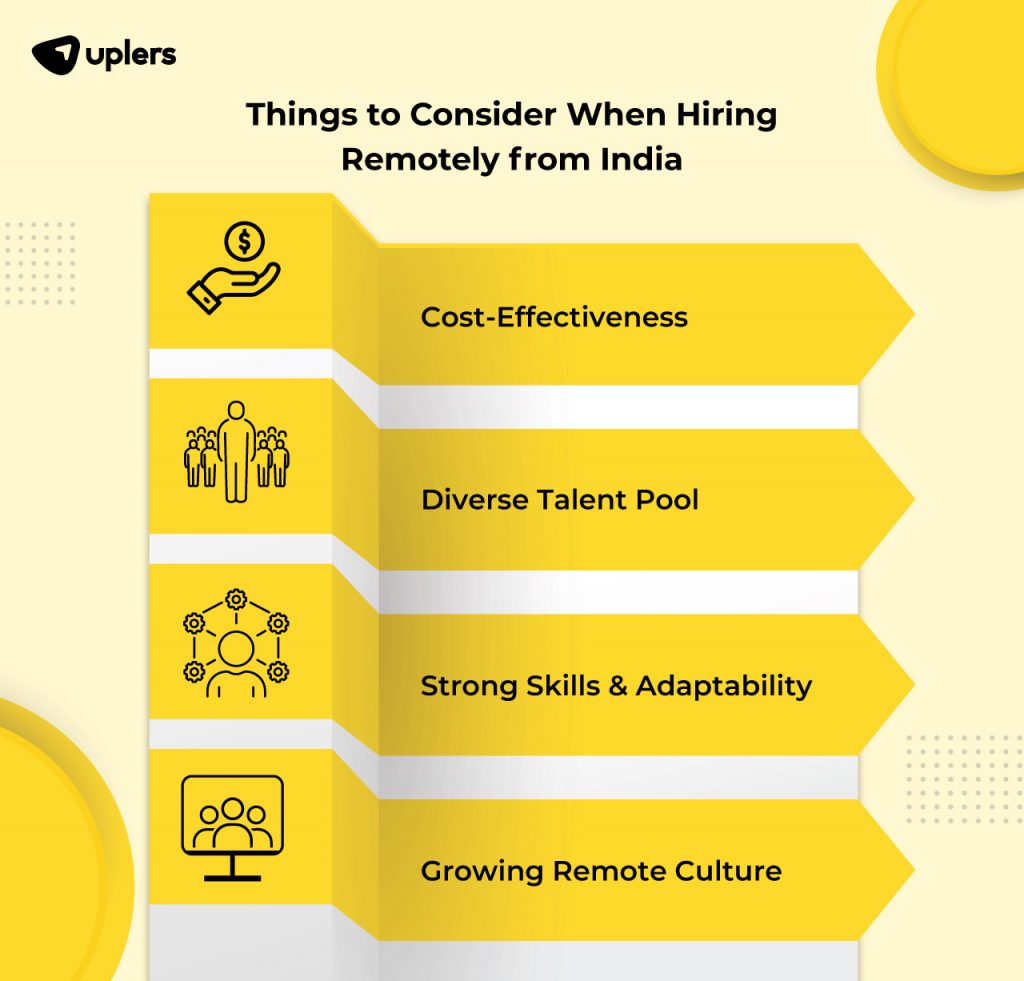
Hiring Remotely From India
Hiring remote IT and tech talent demands a nuanced approach. Look beyond resumes to assess cultural fit, soft skills, and growth potential. Craft targeted job descriptions and leverage AI & ML sourcing tools alongside niche platforms like AngelList and industry-specific boards. Partner with local recruitment specialists and targeted reach. During the screening stage, use comprehensive assessments for technical skills, communication, and remote readiness. Conduct culturally aware virtual interviews while verifying references and qualifications – even utilizing remote verification services. By acknowledging these subtleties, you can discover the hidden potential within your candidates and build a strong, well-rounded remote team.
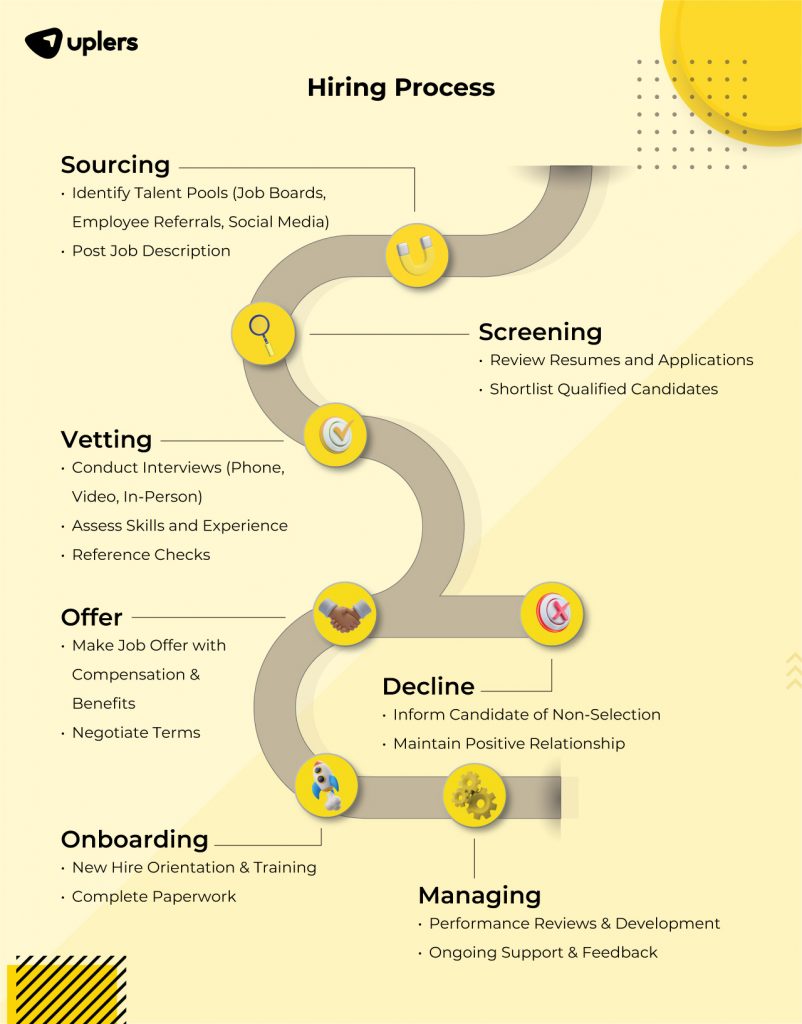
Secure Your Remote Tech and Digital Dream Team: From Offer to Onboarding and Beyond
Secure your remote IT talent by crafting a compelling offer that includes competitive compensation, a remote-friendly benefits package with flexible work arrangements and professional development opportunities. Onboarding sets the stage for success, so design a structured virtual experience to introduce your company culture, values, tools, and team members. Embrace asynchronous communication with platforms like Slack and Asana, and implement remote performance management with clear expectations, regular feedback, and virtual growth opportunities. Invest in cultural sensitivity training and utilize effective remote team management tools for seamless collaboration, fostering a strong and connected team despite geographical separation.
Onboarding, or orientation, is the crucial integration process for your new hires. It’s an ongoing and evolving process, guiding them through the mission, values, culture, teams, systems, and procedures of your company. This comprehensive journey ensures a smooth and positive transition, enabling them to become integral contributors. A strong onboarding program not only fosters connection and belonging but also plays a significant role in employee retention. Studies show that companies with well-designed onboarding programs see significant improvements in keeping new hires, saving time and resources in the long run.
Employee Onboarding Process Flow
Onboarding is a structured process that helps new hires integrate smoothly into your company. This infographic outlines the key steps involved, from pre-boarding to the first quarter.
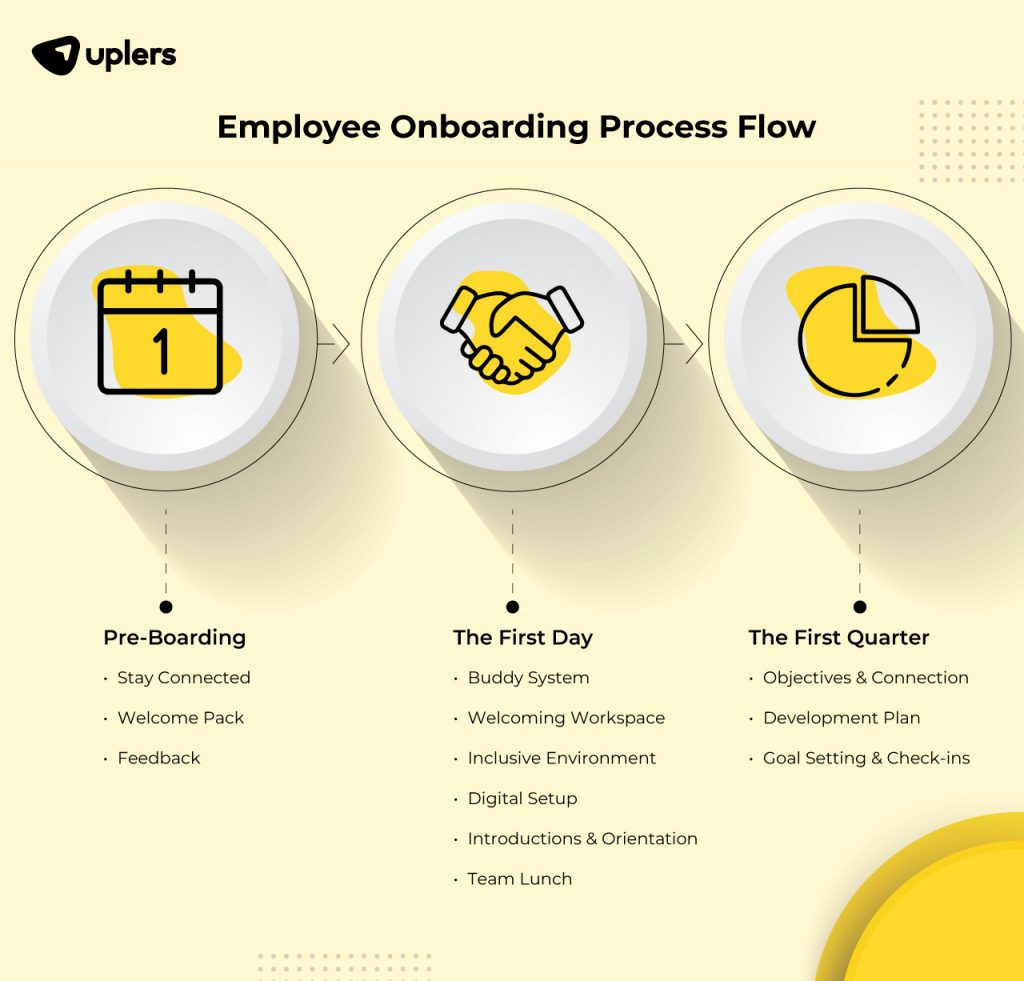
Pre-boarding (Before the First Day):
- Stay Connected: Maintain communication with the new hire to keep them engaged.
- Welcome Pack: Create a welcoming package highlighting company perks and social events.
- Feedback: Gather pre-boarding feedback through surveys to continuously improve the process.
The First Day:
- Buddy System: Assign a buddy to guide and answer questions.
- Welcoming Workspace: Set up a dedicated workspace with essential supplies.
- Inclusive Environment: Verify name pronunciation and learn pronouns.
- Digital Setup: Set up email and send a welcome email to the team.
- Introductions & Orientation: Organize introductions, provide an organizational chart, and guide them to lunch options.
- Team Lunch: Arrange a team lunch to foster a warm welcome.
The First Quarter:
- Objectives & Connection: Focus on introducing objectives, building connections, and providing mentorship.
- Development Plan: Collaborate on a development plan and career path.
- Goal Setting & Check-ins: Set clear, achievable goals and provide regular feedback through check-ins.
Benefits of a Strong Onboarding Process
By providing a structured and supportive onboarding process, you’ll reap benefits that go far beyond the first day and help in managing remote teams better. Here are the benefits –
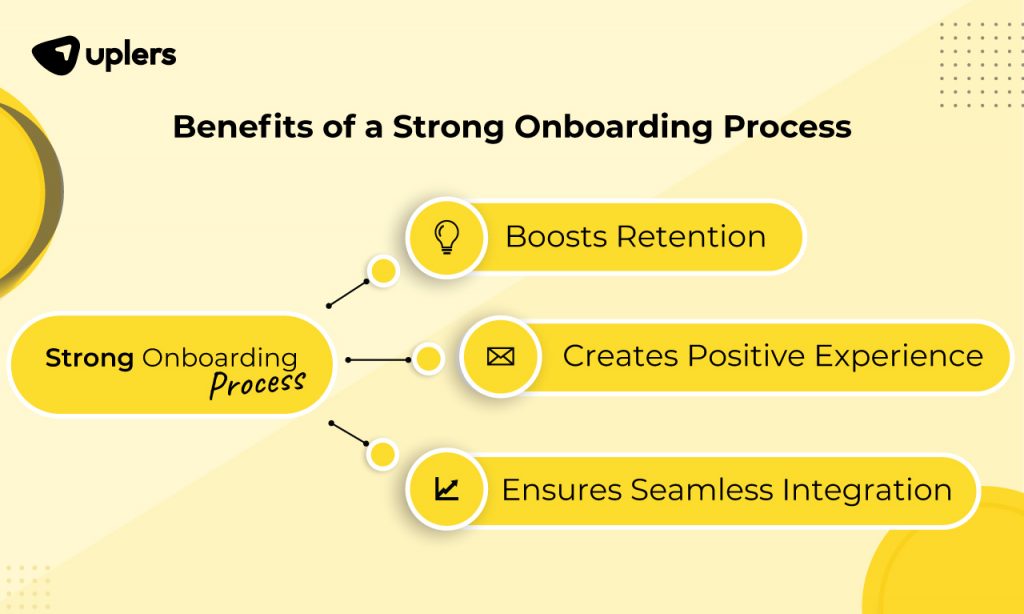
- Increased Retention: Studies show improved retention rates with strong onboarding programs.
- Positive Experience: A positive first-week experience is crucial for new hires.
- Seamless Integration: Onboarding lays the foundation for a successful employee journey.
Managing Remote Indian Talent
Partnering with Uplers can provide you with expert guidance and support for managing remote teams in India. Our expert Talent success coaches offer Fractional HR support which includes L&D mapping and SME (subject matter expert) support for talent’s growth and upskilling. However, if an organization chooses to do it themselves this comprehensive guide will equip you to navigate this process yourself, offering best practices and actionable steps.
Building a Strong Foundation:
- Culture and Values: Thoroughly introduce your company’s mission, vision, and values. Showcase how remote employees contribute and align with these values. Foster participation in virtual team-building activities to deepen connections and build a sense of belonging.
- Technology and Tools: Offer a detailed guide on setting up and using essential remote work tools like video conferencing, project management software, and communication platforms. Include troubleshooting tips for common technical issues and establish clear security protocols for remote access.
- Communication Guidelines: Set clear expectations for communication frequency and methods. Define guidelines for asynchronous communication, outlining response times and preferred methods. Share tips for effective virtual meetings and presentations, emphasizing clear communication and active participation.
Ensuring Productivity and Performance:
- Performance Expectations: Clearly define performance goals and objectives for remote employees. Establish regular check-ins and performance reviews to provide guidance and recognition. Offer resources for professional development and skill enhancement to support continuous growth.
- Assign a Buddy to navigate the system and walkthrough
Remote Work Best Practices Checklist
Empowering Your Team for Success requires a checklist to ensure a smooth journey for the onboarded employee. This infographic highlights key strategies to cultivate a thriving work environment that fosters both productivity and well-being for your employees.
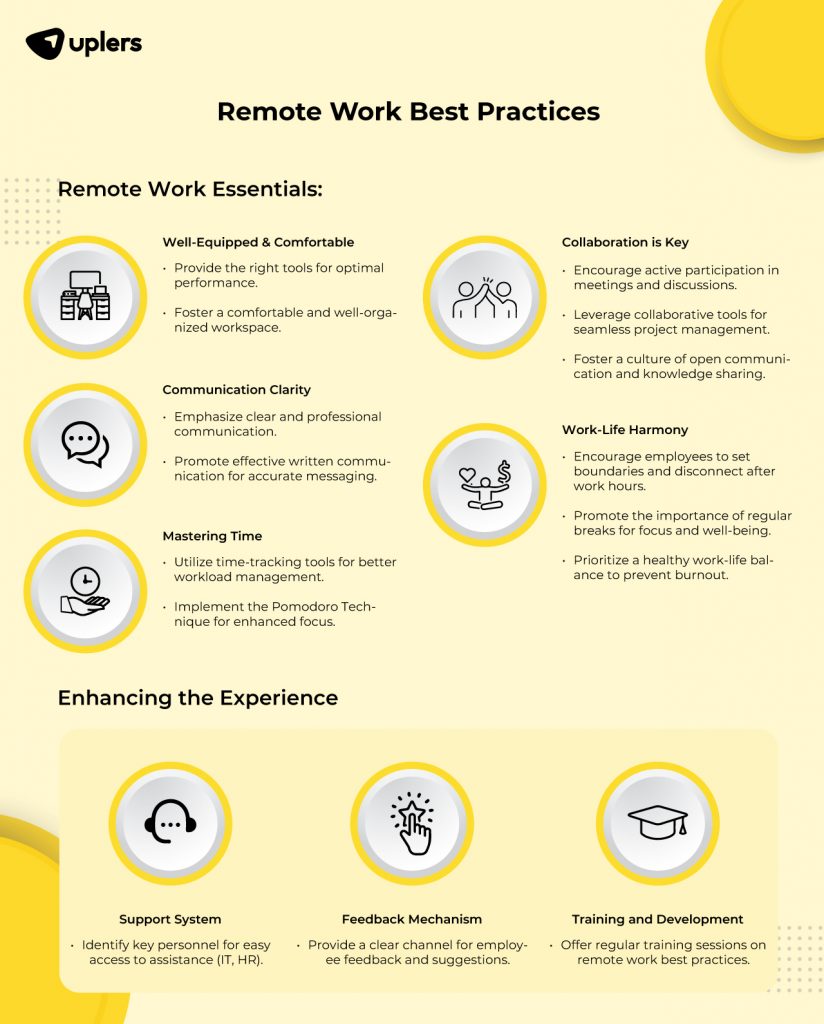
- Equipment & Workspace:
- Provide the right tools: Ensure employees have the necessary equipment for optimal performance.
- Create a productive space: Foster a comfortable and well-organized workspace.
- Communication Etiquette:
- Speak clearly and professionally: Emphasize clear and respectful communication styles in all interactions.
- Write effectively: Promote professional written communication for accurate messaging.
- Time Management:
- Track your time: Utilize time-tracking tools to understand and manage workload.
- Focus and flow: Implement the Pomodoro Technique for enhanced focus and productivity.
- Collaboration Skill:
- Be an active participant: Encourage active engagement in meetings and discussions.
- Leverage tech for teamwork: Utilize collaborative tools for seamless project management.
- Share knowledge: Foster a culture of open communication and knowledge sharing.
- Work-Life Balance:
- Disconnect to recharge: Encourage employees to set boundaries and disconnect after work hours.
- Take breaks: Promote the importance of regular breaks to maintain focus and well-being.
- Balance is key: Prioritize a healthy work-life balance to prevent burnout.
Enhancing the Experience of the Employee
- Support System: Identify key personnel (e.g., IT support, HR) who remote employees can readily reach out to for assistance.
- Feedback Mechanism: Provide a clear channel for employees to share their experiences and suggest improvements to the remote work setup. This feedback can be used to refine your approach and address challenges effectively.
- Training and Development: Offer regular training sessions or workshops facilitated by remote work experts to address common challenges, provide best practice guidance, and support continuous learning and development.
By implementing these best practices and utilizing this guide, you will find building and managing remote teams much easier, and will be able to foster a productive and inclusive work environment for all.


Thank you for submitting the details!
We will keep your information safe. Feel free to contact us with any questions at hello@uplers.com
Please check your email for next steps shared by Robert.












